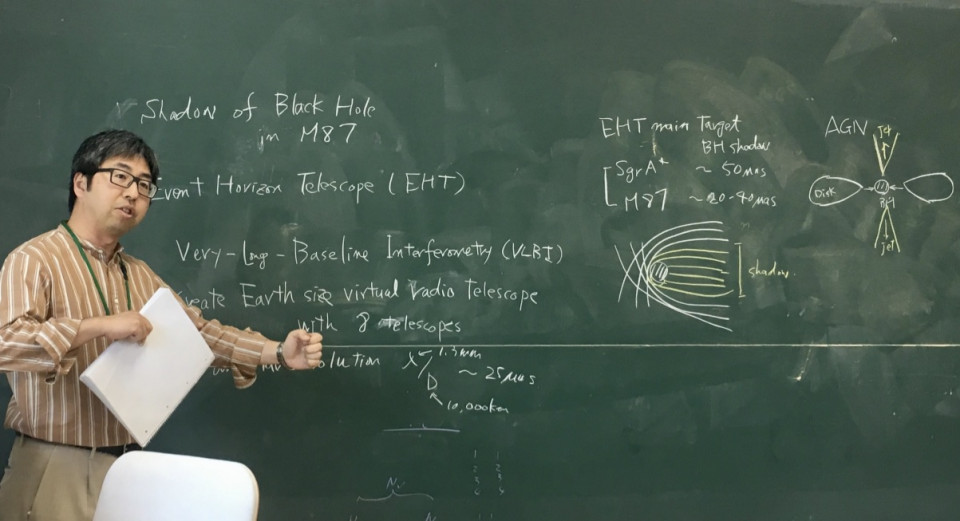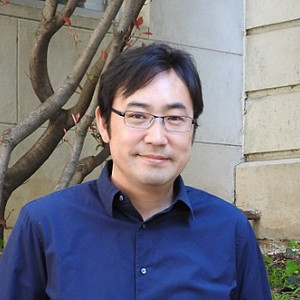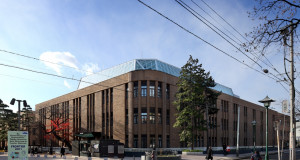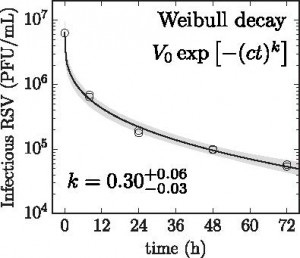Volume 55
Back to Newsletter List
Hot Topic
Introduction to Black Hole Shadow of M87 by Dr. Yosuke Mizuno
2019-05-31
On 24 May (Fri.), Dr. Yosuke Mizuno (Frankfurt U.) visited iTHEMS and gave a 15min talk at iTHEMS coffee meeting. Dr. Yosuke Mizuno is a core member of the Event Horizon Telescope (EHT) project to observe “Black Hole Shadow”. He is a core author of the paper V (theory part) of the first detection of the black hole shadow of M87, which was press-released in the world on 10 April, 2019. In the 15 min talk, Dr. Yosuke Mizuno explained why the black hole shadow is expected from Einstein’s Theory for General Relativity. He also introduced the angular resolution of EHT, which was expected to be smaller than angular size of the black hole shadow of M87. After great efforts of the EHT collaboration, finally the EHT collaboration succeeded to take images of the black hole shadow of M87. This was a big discovery, which confirmed the existence of a Black Hole (independently from gravitational waves), mass of the black hole of M87 (about 6 billion solar mass), and the theory of general relativity. For future works, he introduced some unsolved problems such as confirmation of rotation of the black hole of M87, mechanism of jet formation of M87, and possible correction of Einstein’s theory of general relativity. After the talk, “endless” Q&A was followed between Dr. Yosuke Mizuno many iTHEMS members.
Upcoming Events
Seminar
Quantum Mechanics of an Evaporating Black Hole
June 6 (Thu) 15:30 - 17:00, 2019
Yasunori Nomura (Professor/Director, Berkeley Center for Theoretical Physics, University of California, Berkeley, USA)
Venue: Seminar Room #160, 1F Main Research Building, RIKEN
Event Official Language: English
School
g-RIPS Sendai 2019
June 17 (Mon) - August 9 (Fri) 2019
GRIPS (Graduate-level Research in Industrial Projects for Students)-Sendai program was held last summer (June 18 - Aug. 10, 2018) with the support of iTHEMS as well as other institutions and companies. Two industrial projects were launched under the suggestion of TOYOTA and NEC, and two teams composed of US and Japanese students have worked intensively to find solutions of these problems. See for the details of the GRIPS program and the summary of activities at GRIPS-Sendai 2018.
This year, GRIPS-Sendai program will be held from June 17 through Aug. 9, 2019 with a larger scale under the support of iTHEMS. Stay tuned for further information.
Event Official Language: English
Workshop
Workshop on Sine-square deformation and related topics 2019
July 11 (Thu) 10:00 - 18:00, 2019
Workshop
Co-hosted by iTHEMSSUURI-COOL (Kyoto)
RIMS-iTHEMS joint WS on "Math of Jets"
July 29 (Mon) - 31 (Wed) 2019
Co-hosted by RIMS Kyoto University and iTHEMS RIKEN.
Venue: Kyoto University, Main Campus Research Bldg No 15, #201
Event Official Language: Japanese
Featured Paper of the Week
Uncovering critical properties of the human respiratory syncytial virus by combining in vitro assays and in silico analyses
2019-05-28
When a virion is left in a liquid medium over some time, it loses its ability to infect cells. This is often because the virion surface proteins become deformed, e.g. because of heat or the ionic content of the medium, such that they can no longer effectively bind cells and infect them. For many viruses (e.g. influenza, HIV and hepatitis C) this loss of infectivity over time follows an exponential.
In this paper, we evaluated the rate at which the respiratory syncytial virus (RSV) loses infectivity over time. We were surprised when we found that the loss of infectivity of RSV in our data did not follow an exponential. We used a Weibull distribution to describe the decay and estimated its shape parameter to be k=0.30 [95% credible region: 0.27-0.36], which means the rate of decay gets smaller over time. This is typical of a bad production system wherein a lot of defective products are made which fail soon after production, leaving only well-made products which become defective at a lower rate. In a 2013 paper, Liljeroos and others (doi: 10.1073/pnas.1309070110) showed that as RSV buds from the surface of the cell, bud pinching (closing the bud to free the virion from the cell) is physically difficult, and often leads to misformed buds. The bad structure leads the filamentous (worm-shaped) RSV bud to “plop” outwards (become spherical), flip its surface F proteins (responsible for RSV attachment to host cells) from their pre-trigger (very infectious) to their post-trigger (poorly infectious) state. This is consistent with our finding of k<1, wherein RSV that don’t pinch their bud properly upon cell exit fail (lose infectivity) very early on, and the remaining RSV population which pinched properly will decay following a much less steep exponential.
Reference:
Catherine A. A. Beauchemin, Young-In Kim, Qin Yu, Giuseppe Ciaramella, John P. DeVincenzo
"Uncovering critical properties of the human respiratory syncytial virus by combining in vitro assays and in silico analyses"
PLoS ONE 14(4): e0214708 (2019)
doi: 10.1371/journal.pone.0214708
If you would like to cancel your subscription or change your email address,
please let us know via our contact form.
Copyright © iTHEMS, RIKEN. All rights reserved.






